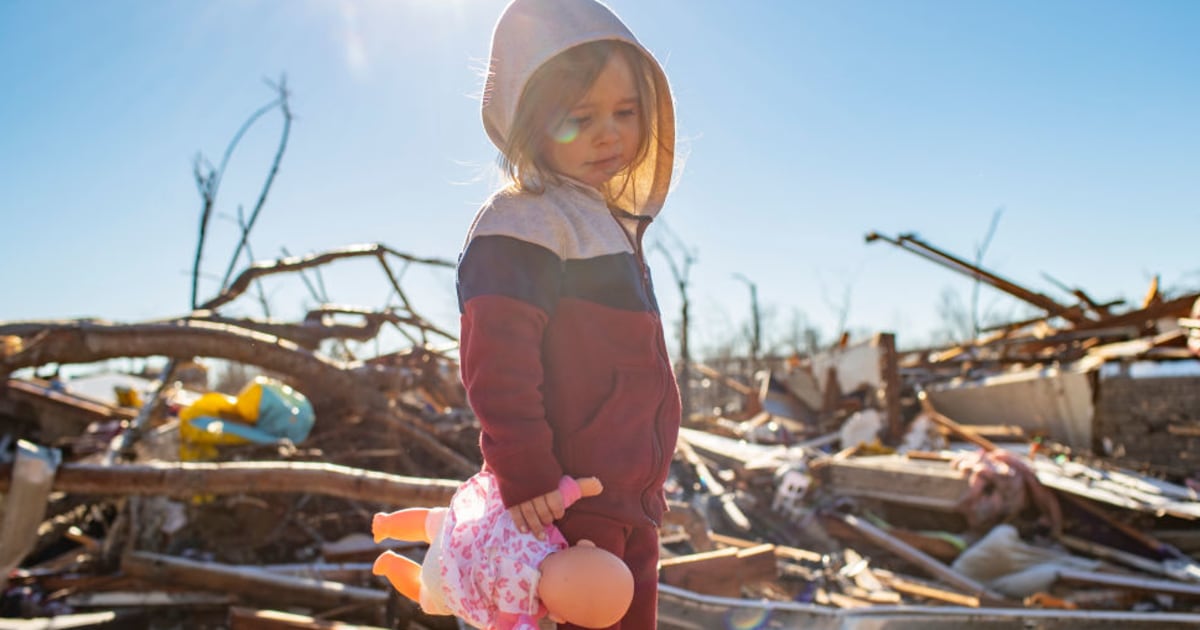By Seth Borenstein -
The Associated Press
The United States suffers much of the bad weather on the planet.
Geography can be blamed for more frequent, severe, costly and varied extreme weather than in any other country in the world, experts say.
Two oceans, the Gulf of Mexico, the Rocky Mountains, exposed peninsulas like Florida, colliding storm fronts, and the jet stream combine to naturally produce the most hostile weather.
But that is only a part.
Nature gave America a bad start, but people have made it worse
with their decisions about what, where and how to build, according to multiple experts.
Add to that climate change, “Hold on.
More extreme events are expected," said Rick Spinrad, head of the US National Oceanic and Atmospheric Administration (NOAA).
Dozens of buildings leveled or damaged after an overnight tornado in Sullivan, Indiana, on Saturday, April 1, 2023. Doug McSchooler / AP
Tornadoes.
Hurricanes.
Flash floods.
droughts.
Forest fires.
Blizzards.
Ice storms.
northeastern fronts.
Lake effect snowfall.
Heat waves.
Strong electrical storms.
Hail.
Good heavens.
atmospheric rivers.
Dust storms.
Monsoons.
explosive cyclogenesis.
And the dreaded polar vortex.
It starts with “where we are on the planet,” explained Kathie Dello, a North Carolina climatologist.
"It really is a bit unfortunate."
["I Saw Houses Flying Everywhere": The Heartbreaking Survival Stories After the Mississippi Tornado]
China may have more people and a larger land area than the United States, but "they don't have the same kind of air mass colliding as the United States, which causes a lot of the bad weather," said Susan Cutter, director of the Institute for Resilience and Vulnerability to Risk at the University of South Carolina.
The United States is the king of tornadoes and other strong storms.
“It actually starts with two things.
The first is the Gulf of Mexico.
And the second is high ground to the west," said Victor Gensini, a professor of meteorology at Northern Illinois University.
Several states are barely recovering from deadly tornadoes and another wave of severe weather is on the way
April 3, 202300:56
Friday's deadly incident is one example, and next week that effect could be seen again: dry air blowing in from the West passes over the Rockies and collides with warm, humid air from the Gulf of Mexico, all added to the stormy current. jet.
In the West it is a succession of atmospheric rivers.
In the Atlantic it's northeasterly storms in the winter, hurricanes in the summer, and sometimes a strange combination of both, like Superstorm Sandy.
"It's a reality that regardless of where you are in the country, where you make your home, you've probably experienced a high-impact weather event firsthand," Spinrad said.
In December 2021, several deadly tornadoes in Kentucky showed the unique character of the United States.
The tornadoes struck regions with significant immigrant communities.
The victims included people who fled Central and South America, Bosnia and Africa.
A big problem was that there are no tornadoes in their hometowns, and they didn't know the warning signs and didn't know what to do or even that they should be worried, explained Joseph Trujillo Falcon, a NOAA scientist who investigated the effects of those storms.
The area between the cold air in the Arctic and the warm climate in the tropics—the mid-latitudes, where the United States is located—has the most interesting weather because of the way the air acts when there is a contrast in temperature and that difference between North and South drives the jet stream, explained Northern Illinois meteorology professor Walker Ashley.
To that are added mountain ranges that go from North to South, between the winds that blow from West to East, and below all the warm Gulf of Mexico.
Deaths increase to at least 30 after several tornadoes pass through 11 states
April 2, 202302:16
The Gulf injects warm and mostly warm air into less cooler and drier air kicked up by the mountains, "and that doesn't really happen anywhere else in the world," Gensini said.
If the United States generally has poor conditions, the South has the worst
, said Marshal Shepherd, a professor of meteorology at the University of Georgia and former president of the American Meteorological Society.
“We have the worst luck (in the South) we can literally experience all types of extreme weather events,” Shepherd said.
“Blizzards, wildfires, tornadoes, floods, hurricanes.
All and each one.
There is no other place in America that can say that."
[A dormant lake has reappeared in California. The havoc is just beginning]
Florida, North Carolina and Louisiana heading out into the water are more likely to be hit by hurricanes, Shepherd and Dello said.
In the South, there are more manufactured homes that are more vulnerable to all sorts of weather hazards
, and storms there are more likely to strike at night, Ashley noted.
Nighttime storms are deadly because people don't see them and are less likely to take cover or watch alerts if they're sleeping.
Extreme weather brought on by America's unique geography creates risks, but it's humans who turn them into disasters, Ashley and Gensini said.
A girl views the rubble of her home in Dawson Springs, Kentucky, in this December 2021 file photo. The Washington Post / The Washington Post via Getty Im
Just look at where cities in the United States stand and compared to the rest of the world: Near floodwaters, except maybe Denver, Cutter said.
There are more people who settle in areas like the South, where there are more risks.
“One of the ways that you can make your communities more resilient is not to build them in the most risk-prone or disaster-prone part,” Cutter said.
"The insistence on building barrier islands and on barrier islands, especially on the East Coast and the Gulf of Mexico Coast, knowing that the sand is going to move and that there are hurricanes with some frequency seems like a huge waste of money."
Building codes tend to stick to the basics and make it less likely to survive storms, Ashley said.
“Our infrastructure is collapsing and is far from climate resilient,” Shepherd said.
[Up to 50 tornadoes ripped across the country, leaving at least 30 dead and towns and cities destroyed]
Poverty makes it harder to prepare for and recover from disasters, especially in the South, Shepherd said.
That vulnerability is an even bigger problem in other parts of the world.
“Security can be bought,” Ashley said.
“People with wealthy incomes and resources can buy security and will be the most resilient when disaster strikes.
Unfortunately, that is not the case for all of us.”
"It's sad that we have to live with these devastating losses
," lamented Kim Cobb, a professor of environment and society at Brown University.
“We are worsening our luck by not understanding the situation of vulnerability, given the geographic fate that has befallen us.”










/cloudfront-eu-central-1.images.arcpublishing.com/prisa/KMEYMJKESBAZBE4MRBAM4TGHIQ.jpg)



